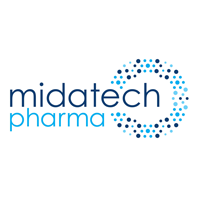Midatech Pharma PLC (LON:MTPH; Nasdaq: MTP), an R&D biotechnology company focused on improving the bio-delivery and biodistribution of medicines, has announced that following completion of one month of treatment with MTX-110 in the first patient, its Phase I study of MTX-110 in recurrent glioblastoma (NCT 05324501) will continue with a planned dose escalation following a positive recommendation from the study’s Data Safety Monitoring Board.
The Phase I study, the MAGIC-G1 study, is an open-label, dose escalation study designed to assess the feasibility and safety of intermittent infusions of MTX-110 administered by convection enhanced delivery (CED) via implanted refillable pump and catheter. The study aims to recruit two cohorts, each with a minimum of four patients; the first cohort will receive MTX-110 only and the second cohort will receive MTX-110 in combination with lomustine.
The first patient in the study was dosed at 60uM of MTX-110 via direct-to-tumour delivery and has received four 48-hour infusions over a period of four weeks. No treatment-associated adverse events were noted in the patient during this period. Following successful completion of the first month of treatment, the DSMB reviewed the available data on 11 January 2023 and recommended dose escalation in the study to 90uM. This dose is expected to be the optimal one of MTX-110 and is the one currently being used in the ongoing Phase I study of patients with diffuse intrinsic pontine glioma (“DIPG”) at the Columbia University, USA.
Patient 1 continues treatment as per the study protocol and patient 2 is expected to start treatment by the end of January 2023 and will receive the 90uM dose.
Commenting, Dr Dmitry Zamoryakhin, MD, MBA, CSO of Midatech, said: “This represents encouraging progress for the MAGIC-G1 study. As the study protocol is based on an accelerated dose escalation approach, with no adverse events seen in the first study patient we are now able to escalate the dose to the concentration that is expected to be optimal in the development of MTX-110. Depending on the safety profile of the higher dose, the study will need to recruit a minimum of 3 more patients before possible progression to the next cohort.”
About Glioblastoma (“GB”)
GB is the most common and devastating primary malignant brain tumour in adults encompassing 14.3% of all primary brain and central nervous system neoplasms(1). With an incidence of approximately 3.2 per 100,000 population in the USA, approximately 12,300 people in the USA will be diagnosed with GB per annum. Standard of care for treatment of GB is typically maximal surgical resection followed by radiotherapy plus concomitant and maintenance temozolomide chemotherapy with or without the Optune® device. Notwithstanding, the multidisciplinary approach, almost all patients experience tumour progression with nearly universal mortality. The median survival from initial diagnosis is less than 21 months(2).
Currently, no standard of care is established for rGB.
Sources:
(1) Low JT, Ostrom QT, Cioffi G, Neff C, Waite KA, Kruchko C, Barnholtz-Sloan JS. Primary brain and other central nervous system tumors in the United States (2014-2018): A summary of the CBTRUS statistical report for clinicians. Neurooncol Pract. 2022 Feb 22;9(3):165-182. doi: 10.1093/nop/npac015. PMID: 35601966; PMCID: PMC9113389.
(2) Stupp R, Taillibert S, Kanner AA, et al. Maintenance Therapy With Tumor-Treating Fields Plus Temozolomide vs Temozolomide Alone for Glioblastoma: A Randomized Clinical Trial. JAMA : the journal of the American Medical Association. 2015;314(23):2535-2543.
Chinot OL, Wick W, Mason W, et al. Bevacizumab plus radiotherapy-temozolomide for newly diagnosed glioblastoma. N Engl J Med. 2014;370(8):709-722.


